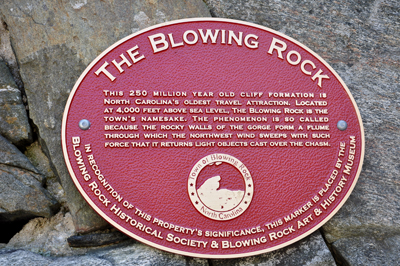
North Carolina
May 5, 2010
 |
at The Blowing Rock, North Carolina May 5, 2010 |
| Plus
a link to the City of Blowing Rock in 2021 at the bottom of this page
with very different photos and information. |
|
| The Blowing Rock, North Carolina's oldest travel attraction since 1933, is an immense cliff 4,000 feet above sea level overhanging Johns River Gorge 3,000 feet below. Open all year weather permitting in Blowing Rock, North Carolina. There is a small entry fee, but in the opinion of the two RV Gypsies, the experience is well worth the small fee. | |
The Legend
of The Blowing Rock |
|
 It
is said that a Chickasaw Chieftain, fearful of a white man's admiration
for his lovely daughter, journeyed far from the plains to bring her to The
Blowing Rock and the care of a squaw mother. One day the maiden, daydreaming
on the craggy cliff, spied a Cherokee Brave wandering in the wilderness
far below and playfully shot an arrow in his direction. The flirtation worked
because soon he appeared before her wigwam, courted her with songs of his
land and they became lovers, wandering the pathless woodlands and along
the crystal streams. It
is said that a Chickasaw Chieftain, fearful of a white man's admiration
for his lovely daughter, journeyed far from the plains to bring her to The
Blowing Rock and the care of a squaw mother. One day the maiden, daydreaming
on the craggy cliff, spied a Cherokee Brave wandering in the wilderness
far below and playfully shot an arrow in his direction. The flirtation worked
because soon he appeared before her wigwam, courted her with songs of his
land and they became lovers, wandering the pathless woodlands and along
the crystal streams.
One day a strange reddening of the sky brought the Brave and the maiden to The Blowing Rock. To him it was a sign of trouble commanding his return to his tribe in the plains. With the maiden's entreaties not to leave her, the Brave, torn by conflict of duty and heart, leaped from The Rock into the wilderness far below. The grief-stricken maiden prayed daily to the Great Spirit until one evening with a reddening sky, a gust of wind blew her lover back onto The Rock and into her arms. From that day a perpetual wind has blown up onto The Rock from the valley below. For people of other days, at least, this was explanation enough for The Blowing Rock's mysterious winds causing even the snow to fall upside down. |
|
 The
Origin of The Blowing Rock. The
Origin of The Blowing Rock. |
|
At the time the rocks of the Blue Ridge Mountains were being thrust up by tremendous forces that slowly squeezed the rocks of the region very much like a huge vise, other natural processes of weathering and erosion started tearing down the young mountains. Now, after more than 250 million years have passed, mountain building has ended and erosion has gradually stripped off the uppermost miles of rocks that were originally here. In the process, rocks that were once buried and squeezed under the weight of miles of rock are now exposed at the top of the Blue Ridge Mountains where we see them at The Blowing Rock and other areas in this region. These old rocks were drastically changed (metamorphosed) by high pressure and temperature during the hundreds of millions of years while they were still buried. Geologists have classified these metamorphic rocks as GNEISS (pronounced "nice"). The age of the gneiss has been determined to be 1,055 million years by the geologists of the U.S. Geological Survey. This age is based on the amount of radioactivity still present in the small crystals of the mineral zircon found in the rock. This particular rock is officially designated THE BLOWING ROCK GNEISS by Geological Survey of The United States. During the formation of the Blue Ridge Mountains, strong pressure in the rocks of the earth's crust produced many features which we now see at The Blowing Rock. These features include the more or less "striped" appearance caused by the alignment of the crystals of minerals in the rock. The pressure also caused many microscopic cracks in the rock. Weathering has widened and enlarged these cracks. Erosion by running water has removed the weathered material to such an extent that the present form of The Blowing Rock has been created. |
|
 |
 |
However, there was NO wind there on the day the two RV Gypsies visited The Blowing Rock - May 5, 2010 |
|
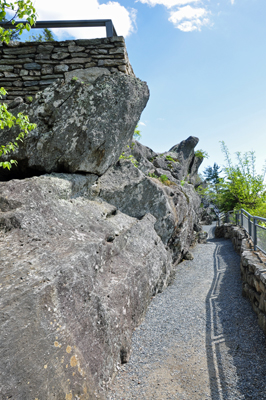 |
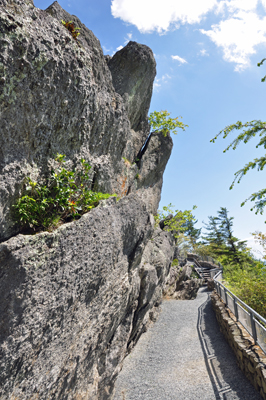 |
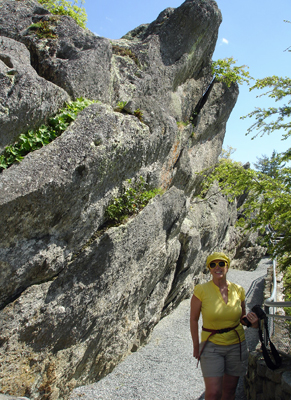 |
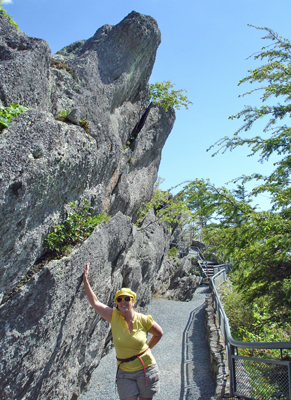 |
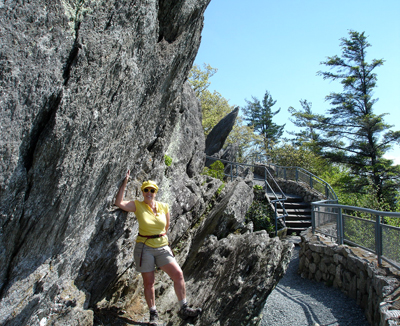 |
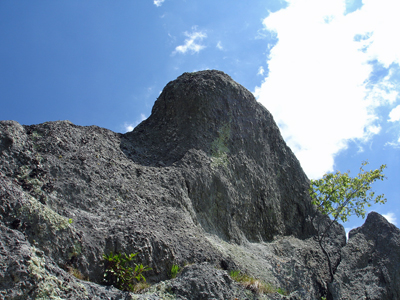 |
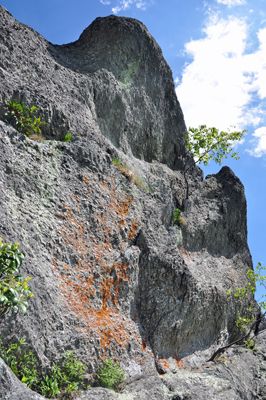 |
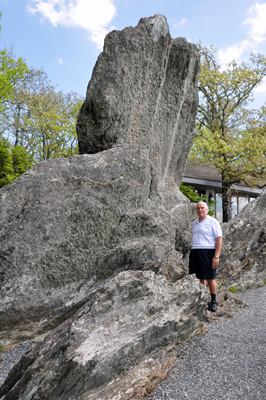 |
| Below: Hawksbill Mountain and Table Rock are visible from The Rock just down the gorge to the southwest. To the west are Grandfather Mountain (the highest peak in the Blue Ridge chain) and Mount Mitchell (the highest peak east of the Mississippi). But the two RV Gypsies did not see any signs at Blowing Rock telling them which mountain is which. | |
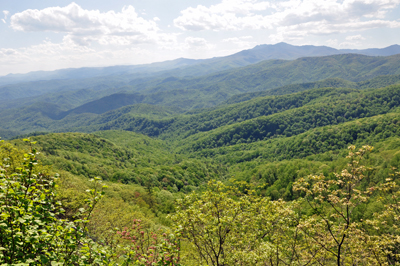 |
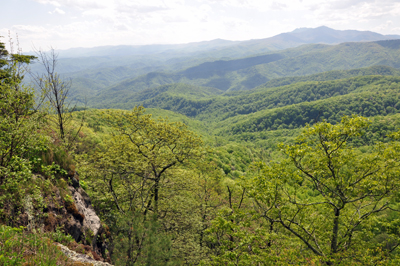 |
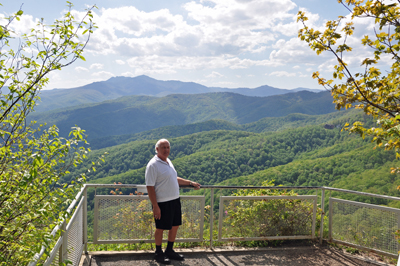 |
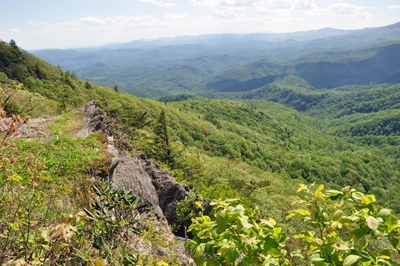 |
Below: Lee Duquette enjoying the view |
Below: Looking down the cliff |
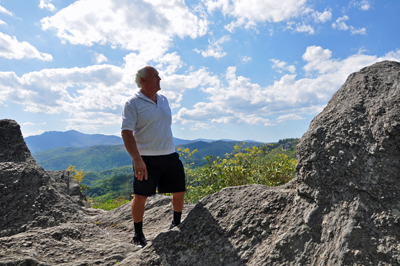 |
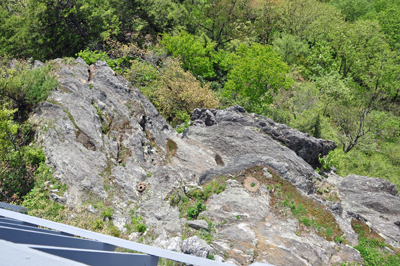 |
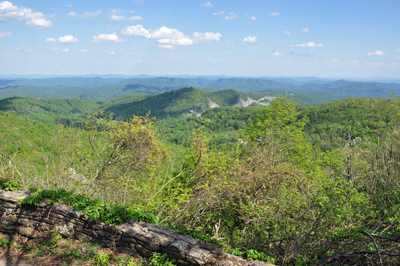 |
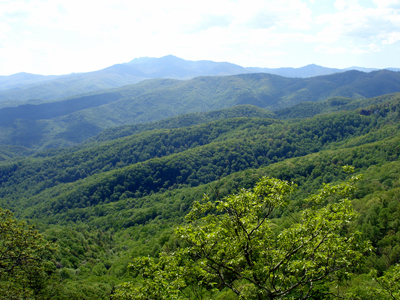 |
Below: Karen Duquette on
top of a big rock at Blowing Rock |
|
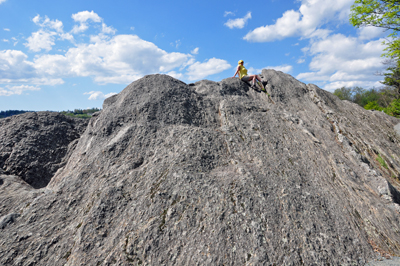 |
 |
| Although the view was absolutely wonderful, and the two RV Gypsies totally enjoyed themselves, this was a very small attraction. It just cannot compare with Grandfather Mountain and so many other places that the two RV Gypsies have visited. | |
| The two RV Gypsies in North Carolina |
|
Blowing
Rock Mountain (this page) |
|
NOTE: The two RV Gypsies returned to Blowing Rock in 2021 and enjoyed some fall colors. If you go there now, there is a link at the TOP of that page to bring you here. |
|
 After
you have viewed all 6 sites above, please continue on for more of the
two RV Gypsies' adventures in North Carolina - a
Segway tour, and lots of waterfalls. After
you have viewed all 6 sites above, please continue on for more of the
two RV Gypsies' adventures in North Carolina - a
Segway tour, and lots of waterfalls. |
OR After you have seen all of the above,Continue Navigation in any year, any place, in the order
of your choice |
|||||

|
|||||
 |
 |
 |
 |
 |
|
 |
 |
 |
 |
 |
|
 |
 |
 |
 |
 |
 |
 |
 |
 |
 |
 |
 |